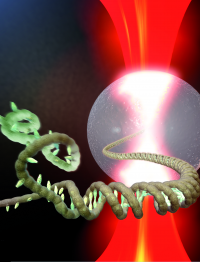DNA falls apart when you pull it

DNA falls apart when you pull it with a tiny force: the two strands that constitute a DNA molecule disconnect. Peter Gross of VU University Amsterdam has shown this in his PhD research project. With this research, researchers can now have a better understanding of how DNA in cells is locally opened so genes can be turned ‘on’ or ‘off’.
DNA is one of the most important molecules in cells because it contains the genetic code. A DNA molecule consists of two strands that are wound around each other and connected together like a spiral staircase: the double helix. Whether the genetic code in a piece of DNA is actually used, partially depends on the ease with which the two DNA strands separate from each other – like a zipper. Because that is required in order to read the genetic code. When you heat DNA in a test tube to about 80 degrees Celsius, the two strands fall apart, they ‘melt’. Cells use a different way to melt DNA: proteins pull the DNA strands apart.
To investigate this process of pulling DNA, Peter Gross used so-called optical tweezers to pull the DNA with tiny forces. Simultaneously, he used fluorescence microscopy to see closely what happens to the DNA. What he saw can be described as a game of tug of war with a frayed rope: when you pull harder, the rope frays further and further apart. When Peter Gross increased the force on the DNA, he saw that the DNA strands fall apart with tiny shocks. He could accurately analyze these shocks and saw that the pattern of shocks is determined by the genetic code of the DNA: the pattern is like a fingerprint of the DNA. He also observed that the two DNA strands spontaneously join together and form a double helix again when he reduced the force on the DNA. This research has led to a better understanding of the complex properties of DNA, in particular the stability of the double helix.
Provided by University of Amsterdam















